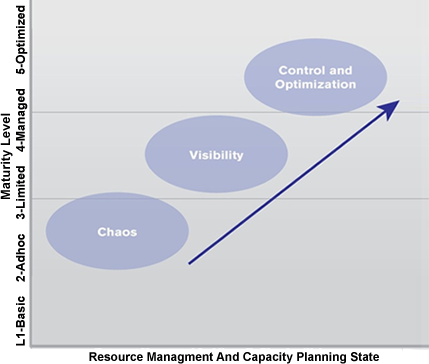By: Innovation Management
While most companies see innovation as a competitive advantage, the ability to take an idea from concept to delivery is truly what sets one company apart from another. Achieving this level of operational efficiency is not a simple feat and without processes around resource management and capacity planning, it is unlikely to succeed. The fact is, no matter how brilliant or timely an idea, if the right resources are not available to work on it, the idea simply remains an idea.
Having a good understanding of your organization’s capacity combined with the ability to align resources to the right products at the right time is critical to product development companies everywhere– as confirmed by the mature organizations in a recent benchmark study sponsored by Planview and conducted by Appleseed Partners. This article is a sneak peek into the findings of The Product Development View of the Resource Management and Capacity Planning Benchmark Study that can help your organization take steps toward a more productive innovation-to-market process.
Summary
In Q4 of 2012, more than 280 globally-based product development executives participated in the Resource Management and Capacity Planning Benchmark Study (Carlson, M. (2013). Resource Management and Capacity Planning Benchmark Study), sharing their top pain points, business risks, pain causes, software impacts, and process improvements relatedto resource management and capacity planning.
According to respondents, there is considerable room for improvementas well as recognition of the potential benefits. Executives areaware of what is at risk and spoke to their goals of improving time to market, reducing the total cost of development, and improving their ability to effectively prioritize winning ideas. They understood that not addressing resource management issues leads directly to problems, including a lack of visibility into demand and capacity that causes ongoing chaos among their teams, missing market windows, and the inability to optimize both people and financial investments.
Those surveyed were not homogeneous. Their problems varied, as indicated by their position on the Resource Management and Capacity Planning Maturity Spectrum (Figure 1). This spectrum allowed participants to identify their groups’ maturity on a five-tier grading system from 1-Basic (having very limited understanding of resources, capacity, and demand) to 5-Optimized (having up-to-date data).
Roughly two-thirds of product organizations identified as low- to mid-level maturity; only a third labeled their organizations with a higher state of maturity, at which point they break through to a certain level of management control and optimization, and thus experienced greater visibility.
Key Findings
What challenges did the product development organizations in this study say they face? The report shows several,including constant change, inaccurate project estimation, and the inability to complete projects on time – many of which your organization may be facing. Tackling these with improvements in resource management and capacity planning is dependent on three things:
- Improved, consistently used processes
- Commitment, follow-through, and executive support
- The right enterprise software for the job
Maturity in resource management and capacity planning enables organizations to tackle the top challenges by better aligning and connecting products with their strategy; enabling management to run critical what-if scenarios in the face of constant change; and ensuring that scarce resources are leveraged wisely for the most competitive offerings and high-value returns.
The Six Characteristics of Mature Organizations
So what does it mean to be a mature organization? As determined in the Resource Management and Capacity Planning Benchmark Study, those organizations that excel at resource management and capacity planning performance tend to:
- Have insight into what people are working on, can identify bottlenecks, and run scenarios on-demand, to adapt to change
- Meld top-down with bottom-up approaches to capacity planning and resource management
- Have a dedicated function to lead resource management and capacity planning activities
- Agree on these top three best practices: prioritization; what-if analysis; executive buy-in
- Estimate projects well and have good supporting processes in place
- Use Product Portfolio Management (PPM) software to optimize their resources
Summary
Process is not the enemy to innovation; rather it’s a support structure.For those surveyed, no matter how mature their resource management and capacity planning performance, all agreedthat their processes needed bolstering. Improving processes actually helps to drive successful innovation andis in every product organizations’ best interest: it derisks the entire portfolio; helps drive down costs; builds efficiencies into projects; encourages innovation by enabling the prioritization of products and resources in line with strategy; and creates an environment that gets products to market faster.
To read the full findings of the study and gather key recommendations for your organization, download the free report.
By Kaylee Kolditz
About the author

Kaylee Kolditz is a Senior Manager at Planview where she has developed a community of product developers and innovators connected through social media tools and the online innovation conference she manages, PIPELINE. Kaylee provides this community with resources from thought-leaders, expert practitioners and industry researchers focused on the areas of innovation, product development and product portfolio management. She has 17 years of experience in developing and executing content and marketing programs primarily in the technology industry. Prior to joining Planview, Kaylee worked for several marketing agencies and also ran her own consulting business. Her clients have included The USPS, Dell, Hewlett-Packard, Visiting Angels, The Hartford Insurance Company, Software House International (SHI), Sara Lee, Calvin Klein, Seton Healthcare Family, Motorola and many others. Kaylee is particularly excited about her role managing the PIPELINE Conference because it connects thousands of innovators from around the globe and is a highly effective vehicle for networking and learning.
Photo from shutterstock.com


